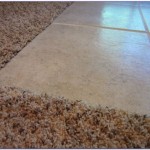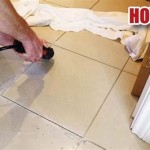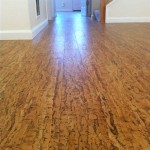Can You Put Tile Directly On Concrete Slab?
Tiling directly onto a concrete slab is a common practice, offering a durable and cost-effective flooring solution. However, several factors determine whether this is a suitable approach for a specific project. The condition of the slab, the type of tile being used, and the expected environmental conditions all play crucial roles in the success of a direct tile installation.
Assessing the Concrete Slab
Before considering direct tile installation, a thorough assessment of the concrete slab is essential. This evaluation should include the following:
*
Moisture Content:
Excessive moisture within the concrete can lead to adhesive failure, tile cracking, and the growth of mold and mildew. Moisture testing is crucial to ensure the slab is sufficiently dry. *Flatness and Levelness:
An uneven surface can create voids beneath the tiles, making them prone to cracking under pressure. A flat and level surface is essential for proper tile adhesion and longevity. *Cracks and Damage:
Existing cracks in the slab should be repaired before tiling to prevent them from transferring to the new tile surface. Significant damage may require professional repair or even slab replacement before tiling can commence. *Cleanliness:
The slab surface must be free of dust, debris, sealers, and other contaminants that could interfere with the bonding of the tile adhesive.Suitable Tile Types for Direct Installation
While many tile types can be installed directly onto concrete, certain types are better suited for this application:
*
Ceramic Tile:
A popular choice due to its durability, affordability, and versatility. *Porcelain Tile:
Known for its high density and resistance to water absorption, making it an excellent choice for wet areas. *Natural Stone Tile:
Some types of natural stone, like slate and granite, are durable enough for direct installation, but require specific adhesives and sealers.Choosing the Right Adhesive
Selecting the correct adhesive is paramount for successful direct tile installation. The adhesive must be compatible with both the concrete slab and the chosen tile type. Key considerations include:
*
Modified Thin-set Mortar:
A versatile option suitable for most tile types and concrete slabs. It provides excellent bonding strength and flexibility. *Medium-bed Mortar:
Used for uneven slabs or larger format tiles, providing a thicker layer to compensate for surface irregularities. *Epoxy Mortar:
Offers superior bonding strength and water resistance, ideal for demanding environments like commercial kitchens or wet areas.Addressing Moisture Concerns
Managing moisture is crucial for the long-term success of tile installed directly on concrete. Several strategies can be employed to mitigate moisture-related issues:
*
Moisture Barriers:
Applying a waterproof membrane to the concrete slab before tiling can prevent moisture from migrating upwards and damaging the tile installation. *Crack Isolation Membranes:
These membranes bridge minor cracks in the slab, preventing them from telegraphing through the tile and providing additional protection against moisture. *Proper Ventilation:
Ensuring adequate ventilation in areas prone to moisture, such as bathrooms, can help reduce the risk of moisture-related problems.Preparing the Concrete Surface
Proper surface preparation is essential for achieving a strong and lasting bond between the tile and the concrete. This process typically involves the following steps:
*
Cleaning:
Thoroughly clean the concrete surface to remove dust, dirt, grease, and any existing coatings. *Repairing Cracks:
Fill any cracks or imperfections with a suitable concrete patching compound. *Priming (If Necessary):
In some cases, a primer may be recommended to enhance adhesion and improve the performance of the tile adhesive.Expansion Joints
Incorporating expansion joints is crucial to accommodate the natural expansion and contraction of the concrete and tile due to temperature fluctuations. These joints should be:
*
Perimeter Joints:
Located around the perimeter of the tiled area, separating the tile from walls and other fixed elements. *Field Joints:
Placed within the tiled area, typically at intervals determined by the size of the tiles and the overall area being tiled. *Filled with Flexible Sealant:
The joints should be filled with a flexible sealant that allows for movement while preventing water penetration.Underfloor Heating Considerations
If installing tile over an underfloor heating system, specific considerations must be addressed:
*
System Compatibility:
Ensure the chosen tile and adhesive are compatible with underfloor heating systems. *Proper Curing Time:
Allow the concrete slab and the heating system to cure completely before tiling. *Gradual Temperature Changes:
Avoid rapid temperature changes during and after installation to prevent stress on the tile and adhesive.Long-Term Maintenance
While tile installed directly on concrete is generally durable, proper maintenance is necessary to ensure its longevity. Regular cleaning with appropriate cleaning products and prompt attention to any cracks or damage can help maintain the integrity of the tile installation.
:max_bytes(150000):strip_icc()/can-you-install-tile-directly-on-concrete-1822600-04-458f7bb6c78348c1835cf8054ef36553.jpg?strip=all)
How To Install Tile Over Concrete

How To Install Tile Over Concrete Greenbuildingadvisor
How To Tile Onto Concrete Floors Porcelain Super
:max_bytes(150000):strip_icc()/can-you-install-tile-directly-on-concrete-1822600-01-8a89ceab1a274fb8ac81890ab7fc6b1b.jpg?strip=all)
How To Install Tile Over Concrete

Can You Lay Outdoor Tiles Over Concrete Premier Porcelain
How To Lay Floor Tiles On Concrete Stonesuper

How To Lay Floor Tiles On Concrete Welcome The Rubi Tools Blog

How To Install Ceramic Tiles On Concrete Floor Tile Installation

Can I Set Tile Directly Over A Concrete Floor

Can You Lay Tiles Onto Damp Concrete Atlas Ceramics
Related Posts








